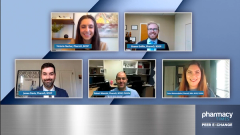
Pharmacist-Led Patient Education Strategies
Pharmacists discuss tailored patient education approaches, emphasizing key medication details, side effects, and financial aspects critical for myelofibrosis care, optimizing adherence and healthcare outcomes.
Episodes in this series

This is a video synopsis/summary of a Peer Exchange involving Zahra Mahmoudjafari, PharmD, MBA, BCOP, FHOPA; James Davis, PharmD, BCOP; Victoria Nachar, PharmD, BCOP; Shawn Griffin, PharmD, BCOP; and Robert Mancini, PharmD, BCOP, FHOPA.
In this segment, Mahmoudjafari asks Davis for insights on how pharmacists can effectively educate myelofibrosis patients and their caregivers about medication regimens and the importance of adherence. Davis emphasizes the pharmacist’s role in culturally respecting patients, incorporating humor for rapport, and involving caregivers. He stresses the need for written materials, offering 1-page education sheets to avoid overwhelming patients. Nachar adds the importance of providing education on common adverse effects and self-management, utilizing reference materials, and discussing financial barriers. Mancini suggests the use of homegrown or oral chemotherapy education sheets for patient education. Griffin highlights the often overlooked aspect of guiding patients on who to contact and how in case of issues, emphasizing the importance of accessibility and clear communication. The panel underscores the significance of pharmacist involvement in patient education and transitions of care, citing evidence that it enhances patient satisfaction, reduces errors, resolves insurance issues, and improves adherence, ultimately contributing to lower hospital readmission rates and improved overall well-being for myelofibrosis patients.
This summary was AI-generated and reviewed by Pharmacy Times® editorial staff.
Newsletter
Stay informed on drug updates, treatment guidelines, and pharmacy practice trends—subscribe to Pharmacy Times for weekly clinical insights.














































































































































































































